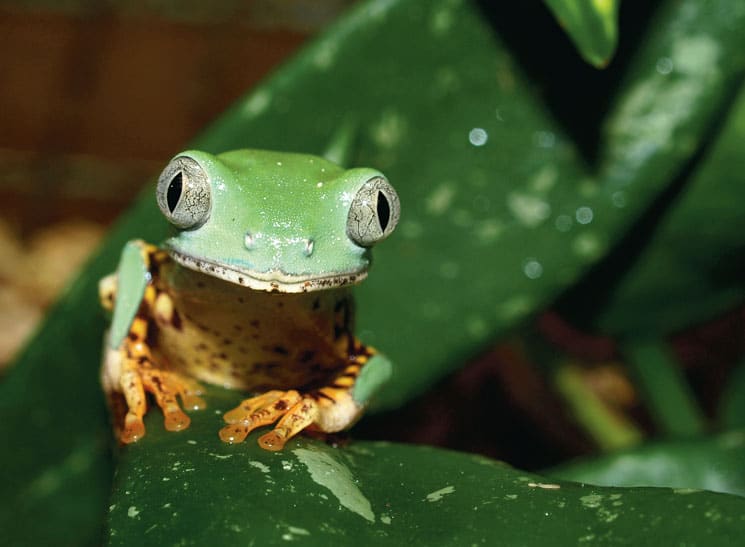If you have the basics of tree frog husbandry down and are looking for a new project, give tiger-legs some serious consideration.
Under appreciated and often over-looked, the tiger-leg monkey frog (Phyllomedusa tomopterna) could easily rival the more-popular red-eyed tree frog (Agalychnis callidryas) as an icon for the diverse amphibian fauna of the Neotropics. Although their colors are less gaudy than red-eyes, tiger-legs are a pleasure to keep in captivity, with a seemingly permanent expression of surprise on their face and an array of entertaining nighttime behaviors. Unlike the more commonly kept monkey frog Phyllomedusa hypochondrialis, P. tomopterna are only infrequently bred in captivity. However, this may be related to a lack of attention rather than difficulty. Frog hobbyists take note-if you have never kept a group of tiger-leg monkey frogs, you are definitely missing out.
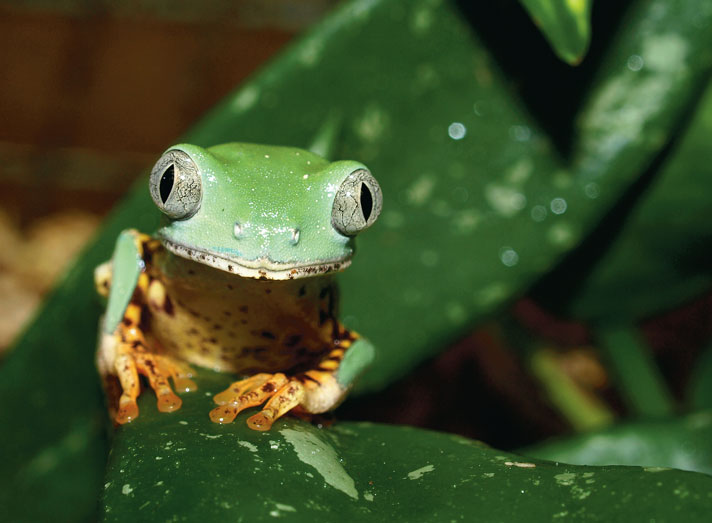
devin edmonds
The common name “monkey frog” is related to their opposable first digit, which they use to grip branches and plants with and is reminiscent of the opposable thumb of primates.
South American Style
The genus Phyllomedusa contains around 30 species of monkey frogs, which are found throughout South America. The common name “monkey frog” is related to their opposable first digit, which they use to grip branches and plants with and is reminiscent of the opposable thumb of primates. Monkey frogs do not hop around, but instead they walk and creep slowly on vegetation at night, sneaking up on prey before a final clumsy lunge. Phyllomedusa tomopterna goes by numerous names, including super tiger-leg monkey frog, tiger-striped monkey frog and barred leaf frog.
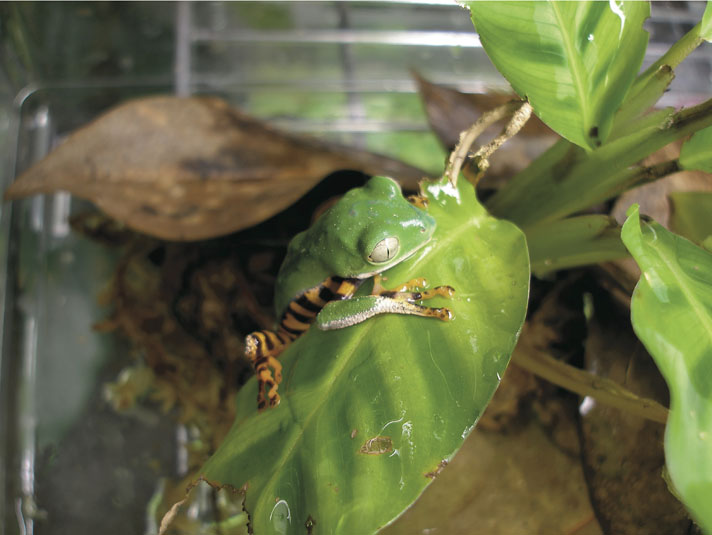
devin edmonds
Monkey frogs do not hop around, but instead they walk and creep slowly on vegetation at night, sneaking up on prey before a final, clumsy lunge.
While a few species, such as the familiar waxy monkey frog (P. sauvagii), inhabit arid regions, most monkey frogs are found in tropical forests. The tiger-leg monkey frog is no exception. It has a large distribution in the lowland rain forests of the Amazon Basin, extending northeast into Guyana, French Guiana and Suriname. They’re often found around swampy areas where there are pools that flood during the rainy season, which is where they breed.
As adults, male tiger-leg monkey frogs usually grow to between 1.7 and 2.1 inches in length, while females are typically larger, up to 2.4 inches long. Dorsally, they are green and blend into the leaves on which they sleep during the day. Coloration varies with temperature and lighting. Tiger-leg monkey frogs can appear almost turquoise in certain conditions, but they are more typically a darker forest green. While asleep during the day, they conceal the bright stripes on their flanks and legs, only exposing the beautiful tangerine and black bands at night when active.
Choosing A Tiger-Leg Monkey Frog
Tiger-leg monkey frogs can be fragile amphibians, and starting off with healthy stock is important for success. Wild-caught tiger-legs are seasonally exported from Suriname each year, but they are best avoided because they can be difficult to acclimate to captivity. Wild-caught individuals may outwardly appear healthy at purchase only to parish several weeks later due to elevated internal parasite levels or bacterial infections which have taken over when their immune system was compromised during transport. If you are going to take the risk to acclimate a group of wild-caught P. tomopterna to captivity, have the assistance of an experienced herp veterinarian on hand, who can diagnose and treat the health problems that are likely to arise.
Fortunately, captive-bred tiger-leg monkey frogs are now sometimes offered for sale and provide prospective monkey-frog keepers with a much safer way to start off. Having struggled myself with the ordeal of medicating and acclimating wild-caught monkey frogs to captivity and later on purchasing trouble-free captive-bred tiger-legs, it is clear which option is best.
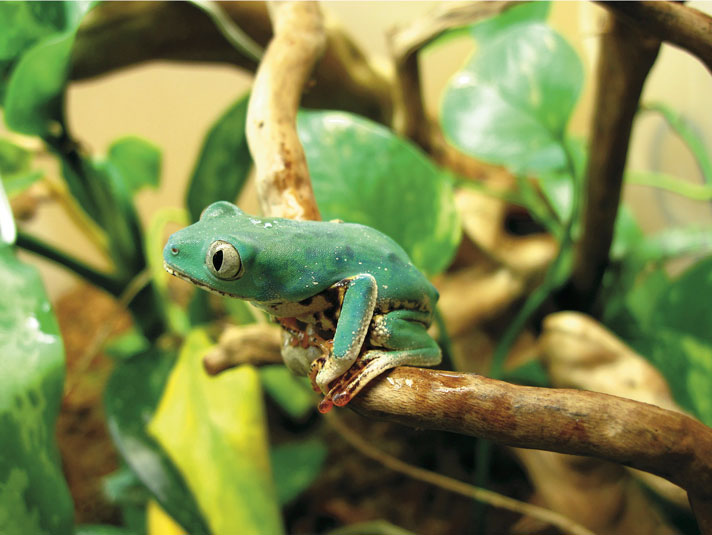
devin edmonds
Monkey frogs make great display animals, but they should not be handled often, if at all, as it can cause them stress.
Captive-bred frogs can be located through reputable frog breeders on the Internet and occasionally at herp expos. Purchase juveniles that are well-started at 1 inch in length or more if possible, and inspect their condition before taking them home if you can. Healthy tiger-leg monkey frogs should be asleep during the day unless they have recently been disturbed. If your goal is to breed them, consider purchasing a large group of eight or more to help ensure you end up with both males and females.
Finding True P. tomopterna
Confusingly, in addition to P. tomopterna, another monkey frog that has orange and black bands on its flanks is sometimes also sold under the common name tiger-leg monkey frog: P. hypochondrialis. Though at first the coloration of P. hypochondrialis can look similar, there are some key differences. First, look at the heel of the frog. Phyllomedusa tomopterna has angular spines at the joint on their legs, while the heels of P. hypochondrialis are smooth and rounded. Compared side by side, P. tomopterna looks streamlined and angular where P. hypochondrialis appears bulky, heavyset and a bit smaller when adult. Lastly, examine the flanks. While the striped pattern of orange and black can vary, it normally does not run along the entire side of the body in P. hypochondrialis, whereas P. tomopterna are fully striped in contrasting bands.
The Ideal Tiger-leg Monkey Frog Enclosure
I’ve used several types of enclosures to house tiger-leg monkey frogs, but all had several things in common, including good ventilation, plenty of perches and plants, and, very important, an easily cleaned water source.
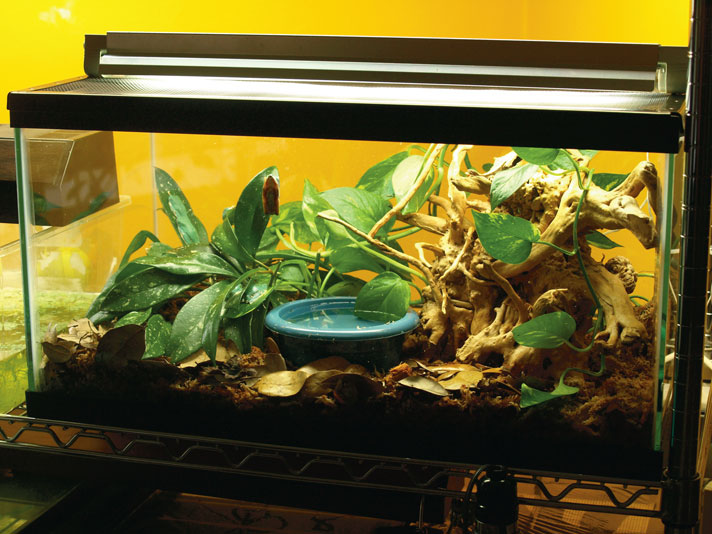
Devin edmonds
A standard 20-gallon aquarium is large enough for a group of six to eight adult frogs.
A standard 20-gallon aquarium is large enough for a group of six to eight adults. Groups of juveniles can be grown in smaller enclosures, such as 5- or 10-gallon aquariums. You can also use plastic storage containers of a similar size for housing. Cut a large hole in the cover of the plastic box and secure fiberglass window screen over it to prevent escapes. Arboreal-style glass herp enclosures with front-opening doors are perhaps the best housing option of all.
Sphagnum moss is an ideal substrate so long as it is kept clean and stays moist. It may not need to be replaced more than every two months or longer if the enclosure is spot cleaned frequently. A sign that the substrate needs to be replaced is the smell. A healthy environment for monkey frogs will smell earthy and fresh, never dank or stagnant. Be careful not to confuse sphagnum moss with other types available in the pet trade. Sphagnum should be light tan in color while less appropriate types of moss are green.
Tightly pat down moist sphagnum moss so that it forms a natural sponge-like substrate. This will help prevent the frogs from accidentally ingesting pieces or being irritated by small bits stuck to their skin. A little leaf litter can then be scattered over the moss to give the terrarium a natural appearance. On occasional days, tiger-leg monkey frogs will sleep on a dead leaf near the bottom of the enclosure. If you don’t want to go with a natural approach using sphagnum moss and dried leaves, paper towels can be used as a substrate instead. Make sure they stay moist (but not overly wet) and replace them several times each week. If the terrarium has a drain in the bottom you may also be able to get away with no substrate at all, so long as waste is flushed clean from the bottom of the enclosure several times each week and there are plenty of places above ground for frogs sleep.
Across the bottom substrate of the terrarium, include several pieces of branching driftwood for the frogs to use as perches at night, as well as a water dish for soaking. A water depth of 1 to 2 inches is adequate. Never use chlorinated water for amphibians. Often, the best option is to treat tap water with a chemical that removes chlorine and chloramines (available where tropical fish supplies are sold) and then let it sit for a day before filling the water dish with it. Chlorine-removing chemicals can be purchased at pet stores in the fish department. Alternatively, some brands of bottled spring water can be used if you don’t trust the quality of your local tap water. The water in the dish should be replaced every day because monkey frogs regularly soak and defecate in it at night.
Tiger-leg Monkey Frog Foliage
Planting the enclosure not only affects the aesthetics of the terrarium but also helps maintain humidity levels and provides sleeping spots for monkey frogs during the day. If you’re hesitant about growing live plants, artificial ones can be used instead but will need to be cleaned now and again with warm water to remove feces and other waste that accumulates on the leaves. Avoid using soaps or detergents to clean artificial plants or other cage items, as residues left behind could potentially harm your frogs.
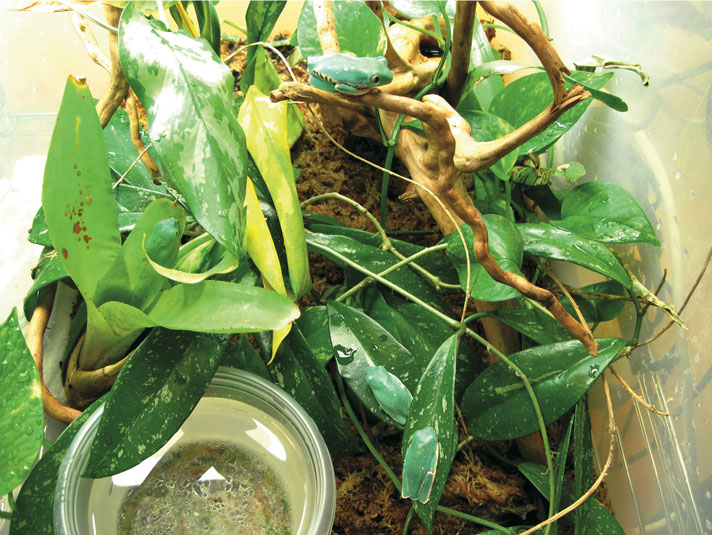
devin edmonds
Across the bottom substrate of the terrarium, include several pieces of branching driftwood for the frogs to use as perches at night, as well as a water dish for soaking.
Choose plants with broad leaves that can support the weight of a monkey frog. Various species of Philodendron, golden pothos (Epipremnum aureum), Chinese evergreens (Aglaonema spp.), and Calathea spp. work well and are commonly available at local garden centers. They can usually grow without problems planted directly in sphagnum moss within the terrarium. Alternatively, more interesting plant species, particularly those suitable for tropical terrariums, are available from specialty terrarium supply companies online and at herp shows.
Always wash plants thoroughly with water before introducing them to a terrarium. If you suspect pesticides, leaf shiners or other potentially harmful chemicals have been used, consider cleaning the plants with water and then growing them outside of the terrarium for several weeks prior to putting them in with the frogs. The best option of all is to prepare the terrarium and plants a week or more in advance of acquiring frogs so that you can ensure environmental conditions inside are suitable for tiger-legs before they are acquired.
Tiger-leg Monkey Frog Lighting
Lighting for tiger-leg monkey frogs provides several things. First, it establishes a natural photoperiod. Set all lamps that emit visible light on an automatic timer to run for 10 to 12 hours per day. The second role of lighting is to regulate temperature. If heating is needed, low-wattage incandescent light bulbs are the best way to heat the terrarium. Those made of red or black glass can be left on overnight and will allow you to view the monkey frogs while they are active.
Consider offering a light that provides low levels of UVB radiation. This will help the frogs metabolize calcium and prevent metabolic bone disease. I used a 2.0-strength bulb over the terrarium of my tiger-leg monkey frogs, placed above the screen section of the enclosure because glass and plastics filter out UVB. Remember that this bulb will need to be replaced at least once annually regardless of if it still emits visible light, and also that the amount of UVB radiation received by the frogs decreases the further away they are from it, so ensure there are perches and leaves where frogs can sleep during the day at least within a foot of the bulb.
The Best Tiger-leg Monkey Frog Enclosure Temperatures
Maintain a daytime temperature range between 75 and 82 degrees Fahrenheit, making sure to use an accurate thermometer to measure the temperature in all parts of the terrarium where the frogs may go. The warmest temperatures should be near the light source during the day and there should always be a cooler area available for the frogs elsewhere in the terrarium. At night, the temperature can drop by 5 to 10 degrees. It is especially important to avoid drafty conditions for tiger-legs where the temperature fluctuates frequently. Keep the terrarium away from windows, doors and air conditioners.
Humidity levels can vary within the terrarium, rising to nearly 100 percent after being misted with water down to between 50 to 80 percent during the rest of the day. You should mist the terrarium at least once daily, sometimes more often if the room the frogs are kept in is particularly dry. Not only does misting help maintain appropriate humidity levels, but it also keeps the substrate moist so live plants can grow. If your tap water is hard, reverse osmosis (RO) water can be used for misting to help avoid water spots from building on the glass.
Sometimes it is difficult to maintain tropical conditions within a terrarium during winter if you live in a temperate climate. Consider taping plastic wrap over half of the screen cover to restrict ventilation and help keep humidity levels up if the enclosures seems to dry quickly. However, it’s important that the environment never becomes stagnant because good air flow is just as, if not more, important than maintaining high levels of humidity.
What To Feed A Tiger-leg Monkey Frog
My favorite part about keeping tiger-leg monkey frogs was watching them stalk prey at night. They are cautious amphibians, almost appearing to walk in slow-motion, carefully sneaking up on unsuspecting crickets and flies before making the attack. Feed them at night because they do not always wake up during the day, even if food is offered. Provide anywhere from two to eight food items per frog at least once every five days or more frequently. Juvenile frogs should be fed every night until they are adult, which could take up to a year.
Want To Learn More?
Tiger-leg Monkey Frog Care Sheet
How To Breed Tiger-Leg Monkey Frogs In Captivity
Crickets can make up the bulk of the captive diet. In addition to crickets, tiger-leg monkey frogs will eat house flies and the larger flightless fruit fly, Drosophila hydei, which should be offered every few feedings for variety. You can also try feeding small roaches and wax worms to monkey frogs. All food items should be no longer than the width of the frog’s mouth.
Dust food items in a high-quality powder nutritional supplement every other feeding. Juveniles can have their food supplemented with vitamins at every feeding. Replace the supplement every three to six months, and make sure it at least contains calcium, vitamin D3, vitamin A and is phosphorus-free.
Final Thoughts
While certainly deserving of more attention within herpetoculture, tiger-leg monkey frogs are not for everyone. They should not be handled frequently, if ever, and the delicate nature of the more commonly available wild-caught imports has put off many amphibian enthusiasts from working with them. Fortunately, captive-bred animals are sporadically available and a much better alternative to imported frogs. If you have the basics of tree frog husbandry down and are looking for a new project, give tiger-legs some serious consideration. They rank high on my list of favorite tree frog species I’ve ever kept.
Devin Edmonds has kept amphibians since childhood and runs a popular website about their care (amphibiancare.com). He currently resides in Madagascar, where he helps coordinate an amphibian captive-breeding facility with the conservation organization Mitsinjo.

